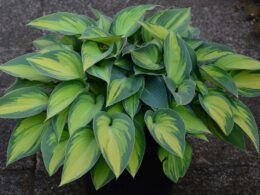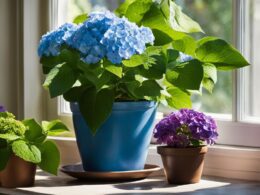Are you looking for a plant that will last you for the next 50 years? You’re not alone. Many people want a plant that they can rely on, that will grow with them, and that can withstand the test of time. But with so many options out there, it can be overwhelming to choose just one.
Fortunately, we’re here to help you find the perfect plant for you.
First and foremost, it’s important to consider your climate and growing conditions. Depending on where you live, certain plants may thrive while others may struggle. You’ll want to consider factors such as temperature, humidity, sunlight, and soil type.
Once you have an idea of what your growing conditions are like, you can start to narrow down your options. From trees to shrubs, succulents to perennials, there are plenty of plants that can last you for 50 years or more – it’s just a matter of finding the right one for you.
Consider the Climate and Growing Conditions
It’s crucial to take into account the climate and growing conditions if you want your greenery to thrive for a long time.
Choosing the appropriate soil is the first step in ensuring a healthy plant. The type of soil you select will depend on the type of plant you choose, as well as the climate in your area. For example, if you live in a dry climate, you may need to choose a soil that retains moisture well.
Watering techniques are also essential for long-term plant growth. Overwatering can be just as detrimental as under-watering, so it’s important to find the right balance. One method is to water deeply and infrequently, allowing the roots to absorb as much water as possible. You should also consider the time of day you water your plants, as early morning or evening watering can help prevent evaporation.
Finally, pruning and maintenance are crucial in sustaining plant health. Regular pruning can help keep your plants healthy and promote new growth. Plants that are not pruned can become overgrown and straggly, which can lead to disease and pest problems.
Additionally, you should regularly inspect your plants for any signs of disease or pests and address any issues immediately to prevent them from spreading. By taking these steps, you can ensure that your plants will thrive for many years to come.
Trees
The forest is filled with towering trees that have stood strong for half a century. If you’re looking to plant a tree that will last 50 years, then it’s important to choose the right one. Tree selection is crucial, as you want to make sure the tree is suited for your climate and growing conditions. Some trees do better in cold weather, while others thrive in heat. Do your research and talk to local experts before selecting a tree.
Once you’ve chosen your tree, it’s important to take good care of it. Regular maintenance is key to ensuring the tree’s longevity. Water the tree regularly, but not too much, as over-watering can lead to root rot. Fertilize the tree once a year, and prune it as necessary. Proper pruning can help the tree grow stronger and healthier.
Planting a tree has many benefits. Trees provide shade, which can help keep your home cooler and reduce your energy bills. They also improve air quality by absorbing pollutants and producing oxygen. Trees can even increase property values, making them a smart investment.
With proper tree selection and maintenance, you can enjoy the benefits of a beautiful tree for 50 years or more.
Is There a Plant That Blooms Only Once Every 12 Years?
Yes, there is a plant that captures attention with its extraordinary blooming pattern. Known as the Agave Americana, this unique succulent species boasts stunning yellow flowers blooming every 12 years. Its long wait between blooms adds to the allure of witnessing this fascinating event, making it a true spectacle in the botanical world.
Shrubs
If you’re looking to add some variety to your garden, consider adding some shrubs!
Boxwood, rhododendron, and azalea are all great options that are easy to maintain and will add some beautiful color and texture to your space.
With a little bit of love and care, these shrubs can thrive for years to come and become a beloved part of your garden.
Boxwood
Boxwood has remained a steadfast presence in gardens for half a century, beloved for its timeless elegance and versatility. This classic shrub is a top choice for gardeners who want to add structure and definition to their landscape. With its small, dense leaves and slow growth habit, boxwood is ideal for creating hedges, topiaries, and other formal garden features.
If you’re considering adding boxwood to your garden, there are several varieties to choose from. American boxwood is a popular choice for its ability to withstand harsh winter weather, while English boxwood is prized for its compact, rounded form. Japanese boxwood is another option, with a finer texture and more upright growth habit.
No matter which variety you choose, boxwood is sure to add a touch of classic elegance to your garden for years to come.
Rhododendron
You’ll love the vibrant blooms of rhododendrons in your garden this spring. These stunning plants come in a variety of colors, from deep reds to soft pinks and whites. One of the most popular varieties is the Catawba rhododendron, which produces large, showy flowers that are sure to catch your eye.
When caring for rhododendrons, it’s important to keep in mind that they prefer acidic soil and partial shade. Be sure to plant them in a location that gets morning sun and afternoon shade.
Water them regularly, but be careful not to overwater, as they are susceptible to root rot. With a little bit of care, your rhododendrons will thrive for many years to come.
Azalea
You may have heard about rhododendrons as a great plant option to last for 50 years, but have you considered azaleas? These beautiful shrubs are not only long-lasting, but they also come in a variety of colors and sizes. Plus, they require minimal maintenance to thrive.
To ensure your azalea plant lasts for decades, it’s important to understand proper pruning techniques. Deadheading spent blooms and removing any diseased or damaged branches will help keep your plant healthy and encourage new growth. Additionally, different varieties of azaleas thrive in different soil types, so research which type will work best in your specific garden.
Whether you choose a small, compact variety or a larger, more showy option, an azalea plant is sure to provide beauty and longevity to your outdoor space.
Succulents and Cacti
If you’re looking for a low-maintenance and visually striking addition to your garden, succulents and cacti are the perfect choice. These plants are known for their unique shapes and textures, as well as their ability to thrive in dry climates. Whether you’re new to gardening or a seasoned pro, succulents and cacti are easy to care for and can be grown in containers or in the ground.
One of the great things about succulents is that they can be propagated very easily. This means that you can take cuttings from an existing plant and use them to grow new ones. To propagate succulents, simply cut off a piece of the plant and let it dry out for a few days. Once the cut is calloused over, you can plant it in well-draining soil and water it sparingly.
Before you know it, you’ll have a whole collection of new succulents to add to your garden. Cacti are another great option for a low-maintenance garden. These plants are known for their ability to store water in their thick stems and can survive for long periods of time without being watered.
To care for cacti, simply plant them in well-draining soil and water them sparingly. With their unique shapes and sizes, cacti can add a striking visual element to any garden. So why not give succulents and cacti a try and see how they can transform your garden into a low-maintenance oasis?
Can the Most Hardy Plant Ever Survive for 50 Years?
Yes, the most hardy plant ever can survive for 50 years. With its ability to withstand harsh conditions and extreme climates, this resilient plant has proven its longevity in various environments. Its resilience and adaptability make it a survivor for decades to come.
Perennials
If you’re looking for low-maintenance plants that will come back year after year, perennials are the way to go.
Three popular options to consider are peonies, daylilies, and coneflowers. These plants are not only easy to care for, but they also come in a variety of colors and add beautiful texture to your garden.
Peonies
As you peruse the section on peonies, you’ll notice the delicate petals and vibrant hues that have captivated gardeners for generations. Peonies have a rich history and come in a variety of colors and types. From the classic pink and white blooms to the more unique coral and yellow hues, there’s a peony for every garden.
If you’re looking to grow peonies but lack garden space, don’t worry! Peonies can also be grown in containers. Just make sure the container is large enough to accommodate the plant’s root system and provide well-draining soil. Keep the container in a spot that receives at least six hours of sunlight a day and water regularly to keep the soil moist.
With proper care, your peony plant will thrive and provide beautiful blooms for years to come.
Daylilies
Get ready to be dazzled by the stunning variety of colors and shapes of daylilies, a beautiful and easy-to-grow flower. Daylilies are a perfect choice for those who want a low-maintenance plant that will bloom year after year.
Daylily cultivation is straightforward and requires minimal effort. You can plant them in almost any soil type, as long as it’s well-draining. Daylilies prefer full sun but will tolerate partial shade. They’re drought-tolerant but will benefit from occasional watering during dry spells. They’re also resistant to pests and diseases, making them an ideal plant for beginners or those who don’t want to spend much time on plant care.
In addition to their beauty and ease of cultivation, daylilies also have symbolic meanings. In some cultures, daylilies represent motherhood and nurturing, while in others, they’re associated with renewal and rebirth. In general, daylilies symbolize beauty, simplicity, and gratitude.
Whether you plant them for their aesthetics or their symbolism, daylilies will bring joy and color to your garden for years to come. So go ahead and plant a few daylilies today, and enjoy their stunning blooms for the next 50 years!
Coneflowers
The next section showcases coneflowers, with their vibrant petals and unique cone-shaped centers. These plants are a perfect addition to your garden if you’re looking for something that will last for 50 years!
Coneflowers attract pollinators and provide numerous benefits for the environment. They’re easy to grow and care for, making them a great choice for beginners and experts alike.
There are many different varieties and colors of coneflowers to choose from. Some popular options include the classic purple coneflower, the bright pink ‘Magnus’, and the stunning yellow ‘Sunrise’. Each variety has its own unique characteristics that make it stand out in any garden.
Whether you’re looking for a bold statement or a subtle addition, coneflowers have something for everyone.
Frequently Asked Questions
How do I maintain my chosen plant for 50 years?
To maintain your chosen plant for 50 years, there are a few things to keep in mind. Firstly, make sure to water it frequently, as this is essential for healthy growth.
You should also take note of the sunlight requirements for your specific plant and ensure that it gets enough light to thrive.
Another important factor is the type of soil you use, as some soil types are better suited for long-term plant growth than others.
By staying on top of these key elements, you can help ensure your plant stays healthy and vibrant for many years to come.
Can I plant multiple varieties of plants together?
If you’re interested in gardening, you might be wondering if you can plant multiple varieties of plants together. The answer is yes!
In fact, companion planting benefits both you and your plants. By using interplanting techniques, you can create a healthier ecosystem in your garden. This results in plants that support each other and ward off pests and diseases.
For instance, planting marigolds near vegetables like tomatoes can repel harmful insects and improve soil quality. Similarly, planting herbs like basil alongside your vegetables can improve their flavor and scent while also deterring pests.
So go ahead and experiment with different combinations of plants. Not only will it make your garden more beautiful, but it will also promote a thriving and sustainable ecosystem.
What are some common pests and diseases that my chosen plant may face?
To keep your plants healthy and thriving for the next 50 years, it’s important to know the common pests and diseases that they may face. Preventing infestations is key, and there are many natural remedies you can use to keep your plants free of harmful bugs and diseases.
One effective method is companion planting, where you plant certain herbs and flowers alongside your chosen plant to repel pests. You can also use natural insecticides such as neem oil and garlic spray to keep pests at bay.
Regularly inspecting your plants for signs of infestation and promptly addressing any issues is also crucial in preventing the spread of pests and diseases. By taking these preventative measures, you can ensure that your plants will continue to thrive for years to come.
How often should I fertilize my plant?
When it comes to fertilizing your chosen plant, it’s important to consider the type of fertilizer you use. Organic fertilizers are made from natural sources and are gentler on the soil and plant, while chemical fertilizers are made from synthetic substances and can be harsher.
It’s also crucial to test your soil before fertilizing to determine its nutrient needs. Over-fertilizing can lead to nutrient imbalances or even harm the plant. So, it’s essential to fertilize in moderation and at the appropriate time.
By using the right type of fertilizer and soil testing, you can ensure your plant stays healthy and strong for years to come.
Are there any specific pruning techniques that I should use for my chosen plant?
When it comes to pruning your chosen plant, it’s important to know the benefits and avoid common mistakes. Pruning benefits include promoting healthy growth, improving the overall appearance of the plant, and increasing its resistance to disease and pests.
However, pruning mistakes like cutting too much or at the wrong time can harm the plant, leading to stunted growth or even death. To avoid these mistakes, make sure to use sharp, clean tools, only prune during the appropriate season, and only remove dead or damaged branches.
By following these tips, you can ensure the longevity and health of your plant for years to come.
Conclusion
So, you want to plant something that’ll last for 50 years? Well, there are plenty of options available to you. However, the key to success is choosing the right plant for your specific climate and growing conditions.
If you live in an area with harsh winters, for example, you’ll want to consider planting a tree or shrub that can withstand the cold. On the other hand, if you live in a hot, dry climate, succulents and cacti might be a better choice.
Regardless of what you choose, remember that planting a tree or shrub is a long-term commitment. It requires patience, care, and attention, but the rewards are well worth it.
Not only will you be able to enjoy the beauty of your plant for years to come, but you’ll also be doing your part to help the environment. So, take some time to research your options, and don’t be afraid to ask for help if you need it.
Happy planting!








